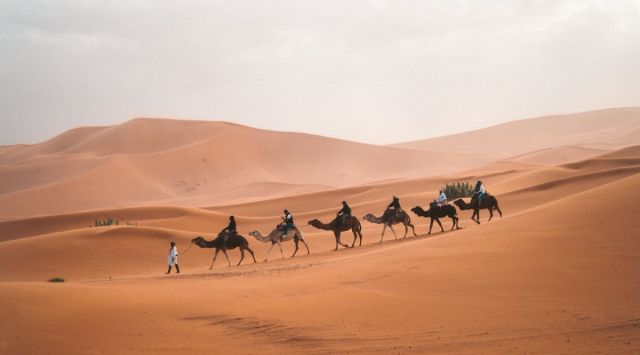- India
- International
New study sheds light on when and how the Sahara desert turned green
The Sahara desert periodically turned green with savannahs, rivers, lakes and water-dependent animals over history. A new study helps scientists understand why that happens.
 A man leads a pack of camels through the Sahara Desert. (Taryn Elliot via Pexels)
A man leads a pack of camels through the Sahara Desert. (Taryn Elliot via Pexels) The Sahara desert today covers an area of around 9,200,000 square kilometres and is one of the largest hot deserts in the world. But over the last few millenia, this desert sometimes turned green with savannahs, rivers, lakes and water-dependent animals like hippos. A new research study reveals when and how these “green phases” happened.
The research study was published in the journal Nature Communications on Friday and shows how the periodic wet phases in the Sahara desert were caused by changes in Earth’s orbit around the Sun. These wet periods were also suppressed during the ice ages.
“The cyclic transformation of the Sahara Desert into savannah and woodland ecosystems is one of the most remarkable environmental changes on the planet. Our study is one of the first climate modelling studies to simulate the African Humid Periods with comparable magnitude to what the palaeoclimate observations indicate, revealing why and when these events occurred,” said lead author Edward Armstrong in a press statement. Armstrong is a climate scientist at the University of Helsinki and the University of Bristol.
There is already a lot of evidence to support the claim that the Sahara was periodically vegetated in the past. These “North African humid periods” may have played an important role in providing vegetated corridors out of Africa. This in turn could have allowed the dispersal of various species, even early humans, around the world.
This new study suggests that these “greenings” may have been driven by changes in Earth’s orbital precession. Precession refers to how the Earth wobbles on its axis. This influences seasonality over an approximately 21,000-year cycle. The changes in precession also decide the amount of energy received by the planet during different seasons. This then controls the strength of the African Monsoon and the spread of vegetation across the region.

The study used complex climate models to confirm that the North African humid periods happened every 21,00 0 years, determined by changes in the planet’s orbital precession. These changes caused warmer summers in the Northern hemisphere and thereby increased the strength of the West African monsoon system. This increased rain in the Sahara, causing the spread of savannah-type vegetation through the desert.
The study also found that these humid periods did not happen during ice ages. This is because ice ages cause glacial ice sheets to cover most of the higher latitudes. These sheets then cooled the atmosphere and suppressed the humid periods.
More Tech
May 13: Latest News
- 01
- 02
- 03
- 04
- 05







































